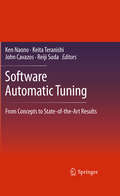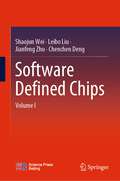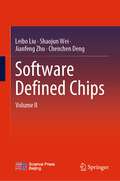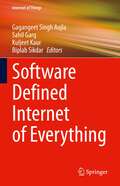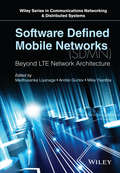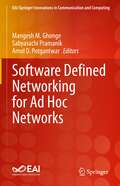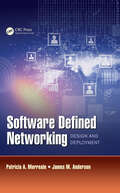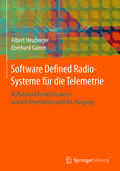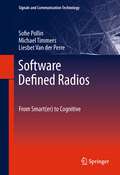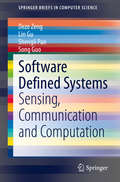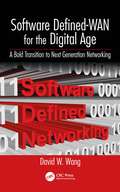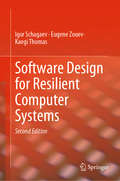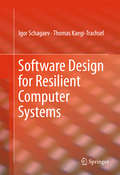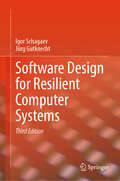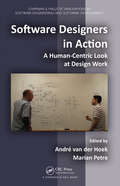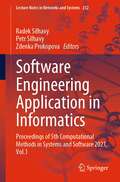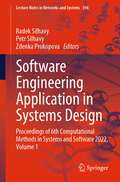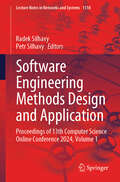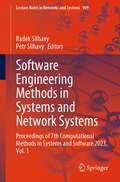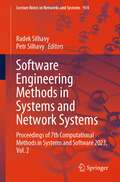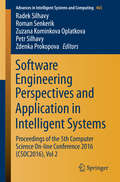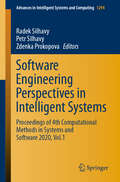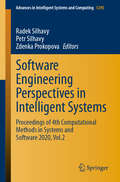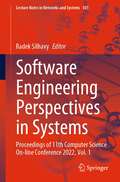- Table View
- List View
Software Automatic Tuning
by Keita Teranishi Reiji Suda John Cavazos Ken NaonoAutomatic Performance Tuning is a new software paradigm which enables software to be high performance in any computing environment. Its methodologies have been developed over the past decade, and it is now rapidly growing in terms of its scope and applicability, as well as in its scientific knowledge and technological methods. Software developers and researchers in the area of scientific and technical computing, high performance database systems, optimized compilers, high performance systems software, and low-power computing will find this book to be an invaluable reference to this powerful new paradigm.
Software Defined Chips: Volume I
by Leibo Liu Shaojun Wei Jianfeng Zhu Chenchen DengThis is the first book of a two-volume book set which introduces software defined chips. In this book, it introduces the conceptual evolution of software defined chips from the development of integrated circuits and computing architectures. Technical principles, characteristics and key issues of software defined chips are systematically analyzed. The hardware architecture design methods are described involving architecture design primitives, hardware design spaces and agile design methods. From the perspective of the compilation system, the complete process from high-level language to configuration contexts is introduced in detail. This book is suitable for scientists and researchers in the areas of electrical and electronic engineering and computer science. Postgraduate students, practitioners and professionals in related areas are also potentially interested in the topic of this book.
Software Defined Chips: Volume II
by Leibo Liu Shaojun Wei Jianfeng Zhu Chenchen DengThis book is the second volume of a two-volume book set which introduces software-defined chips. In this book, the programming model of the software-defined chips is analyzed by tracing the coevolution of modern general-purpose processors and programming models. The enhancement in hardware security and reliability of the software-defined chips are described from the perspective of dynamic and partial reconfiguration. The challenges and prospective trends of software-defined chips are also discussed. Current applications in the fields of artificial intelligence, cryptography, 5G communications, etc., are presented in detail. Potential applications in the future, including post-quantum cryptography, evolutionary computing, etc., are also discussed. This book is suitable for scientists and researchers in the areas of electrical and electronic engineering and computer science. Postgraduate students, practitioners and professionals in related areas are also potentially interested in the topic of this book.
Software Defined Internet of Everything (Internet of Things)
by Gagangeet Singh Aujla Sahil Garg Kuljeet Kaur Biplab SikdarThis book provides comprehensive discussion on key topics related to the usage and deployment of software defined networks (SDN) in Internet of Everything applications like, healthcare systems, data centers, edge/fog computing, vehicular networks, intelligent transportation systems, smart grids, smart cities and more. The authors provide diverse solutions to overcome challenges of conventional network binding in various Internet of Everything applications where there is need of an adaptive, agile, and flexible network backbone. The book showcases different deployment models, algorithms and implementations related to the usage of SDN in Internet of Everything applications along with the pros and cons of the same. Even more, this book provides deep insights into the architecture of software defined networking specifically about the layered architecture and different network planes, logical interfaces, and programmable operations. The need of network virtualization and the deployment models for network function virtualization is also included with an aim towards the design of interoperable network architectures by researchers in future. Uniquely, the authors find hands on practical implementation, deployment scenarios and use cases for various software defined networking architectures in Internet of Everything applications like healthcare networks, Internet of Things, intelligent transportation systems, smart grid, underwater acoustic networks and many more. In the end, design and research challenges, open issues, and future research directions are provided in this book for a wide range of readers
Software Defined Mobile Networks (SDMN)
by Andrei Gurtov Madhusanka Liyanage Mika YlianttilaThis book describes the concept of a Software Defined Mobile Network (SDMN), which will impact the network architecture of current LTE (3GPP) networks. SDN will also open up new opportunities for traffic, resource and mobility management, as well as impose new challenges on network security. Therefore, the book addresses the main affected areas such as traffic, resource and mobility management, virtualized traffics transportation, network management, network security and techno economic concepts. Moreover, a complete introduction to SDN and SDMN concepts. Furthermore, the reader will be introduced to cutting-edge knowledge in areas such as network virtualization, as well as SDN concepts relevant to next generation mobile networks. Finally, by the end of the book the reader will be familiar with the feasibility and opportunities of SDMN concepts, and will be able to evaluate the limits of performance and scalability of these new technologies while applying them to mobile broadband networks.
Software Defined Networking for Ad Hoc Networks (EAI/Springer Innovations in Communication and Computing)
by Sabyasachi Pramanik Mangesh M. Ghonge Amol D. PotgantwarThis book offers a comprehensive overview of Software-Defined Network (SDN) based ad-hoc network technologies and exploits recent developments in this domain, with a focus on emerging technologies in SDN based ad-hoc networks. The authors offer practical and innovative applications in Network Security, Smart Cities, e-health, and Intelligent Systems. This book also addresses several key issues in SDN energy-efficient systems, the Internet of Things, Big Data, Cloud Computing and Virtualization, Machine Learning, Deep Learning, and Cryptography. The book includes different ad hoc networks such as MANETs and VANETs, along with a focus on evaluating and comparing existing SDN-related research on various parameters. The book provides students, researchers, and practicing engineers with an expert guide to the fundamental concepts, challenges, architecture, applications, and state-of-the-art developments in the field.
Software Defined Networking: Design and Deployment
by Patricia A. MorrealeSoftware Defined Networking: Design and Deployment provides a comprehensive treatment of software defined networking (SDN) suitable for new network managers and experienced network professionals. Presenting SDN in context with more familiar network services and challenges, this accessible text:Explains the importance of virtualization, particularly
Software Defined Radio-Systeme für die Telemetrie: Aufbau und Funktionsweise von der Antenne bis zum Bit-Ausgang
by Albert Heuberger Eberhard GammDieses Buch behandelt alle für ein Software Defined Radio (SDR) relevanten Systemteile: Antenne, Antennenanpassung, analoges Frontend, A/D-Umsetzung, Digital Downconversion (DDC), Interpolation, Synchronisation, Demodulation. Zunächst werden die notwendigen Grundlagen für die Darstellung von Signalen vermittelt sowie der gesamte Aufbau eines Software Defined Radios beschrieben, um anschließend die einzelnen Komponenten näher zu betrachten.Der Schwerpunkt des Buches liegt auf dem Zusammenspiel der Komponenten und Signale innerhalb des Empfängers. Zur Veranschaulichung der Signale wird das Open-Source-Programm GNU Octave verwendet.
Software Defined Radios
by Michael Timmers Sofie Pollin Liesbet Van der PerreMany and ever more mobile users wish to enjoy a variety of multimedia services, in very diverse geographical environments. The growing number of communication options within and across wireless standards is accommodating the growing volume and heterogeneity in wireless wishes. On the other hand, advancement in radio technologies opening much more flexibility, a.o. through Software Defined Radios, opens up the possibility to realize mobile devices featuring multi-mode options at low cost and interesting form factors. It is crucial to manage the new degrees of freedom opened up in radios and standards in a smart way, such that the required service is offered at satisfactory quality as efficiently as possible. Efficiency in energy consumption is clearly primordial for battery powered mobile terminals specifically, and in the context of growing ecological concerns in a broader context. Moreover, efficient usage of the spectrum is a growing prerequisite for wireless systems, and coexistence of different standards puts overall throughput at risk. The management of flexibility risks bringing about intolerable complexity and hamper the desired agility. A systematic approach, consisting of anticipative preparing for smooth operation, allows mastering this challenge. Case studies show that already today, this approach enables smart operation of radios realizing impressive efficiency gains without hampering Quality-of-Service. In the future wireless communication scenes will be able to profit form the opening of the spectrum. Even smarter and cognitive behavior will become possible and essential.
Software Defined Systems: Sensing, Communication and Computation (SpringerBriefs in Computer Science)
by Song Guo Deze Zeng Lin Gu Shengli PanThis book introduces the software defined system concept, architecture, and its enabling technologies such as software defined sensor networks (SDSN), software defined radio, cloud/fog radio access networks (C/F-RAN), software defined networking (SDN), network function virtualization (NFV), software defined storage, virtualization and docker. The authors also discuss the resource allocation and task scheduling in software defined system, mainly focusing on sensing, communication, networking and computation. Related case studies on SDSN, C/F-RAN, SDN, NFV are included in this book, and the authors discuss how these technologies cooperate with each other to enable cross resource management and task scheduling in software defined system. Novel resource allocation and task scheduling algorithms are introduced and evaluated. This book targets researchers, computer scientists and engineers who are interested in the information system softwarization technologies, resource allocation and optimization algorithm design, performance evaluation and analysis, next-generation communication and networking technologies, edge computing, cloud computing and IoT. Advanced level students studying these topics will benefit from this book as well.
Software Defined-WAN for the Digital Age: A Bold Transition to Next Generation Networking
by David W. WangSD-WAN is an advanced networking approach that creates hybrid networks to integrate broadband or other network services into the corporate WAN, not only just handling general business workloads and traffic, but also being capable of maintaining the performance and security of real-time and sensitive applications. This book posits that Software Defined (SD) WAN is the answer to questions such as what changes can be made to the networking sector? What innovations can make WAN, which plays a vital integrated part of the cloud ecosystem, more cost effective, performance robust, provisioning efficient, and operation intelligent?
Software Design for Resilient Computer Systems
by Igor Schagaev Eugene Zouev Kaegi ThomasThis book addresses the question of how system software should be designed to account for faults, and which fault tolerance features it should provide for highest reliability. With this second edition of Software Design for Resilient Computer Systems the book is thoroughly updated to contain the newest advice regarding software resilience. With additional chapters on computer system performance and system resilience, as well as online resources, the new edition is ideal for researchers and industry professionals.The authors first show how the system software interacts with the hardware to tolerate faults. They analyze and further develop the theory of fault tolerance to understand the different ways to increase the reliability of a system, with special attention on the role of system software in this process. They further develop the general algorithm of fault tolerance (GAFT) with its three main processes: hardware checking, preparation for recovery, and the recovery procedure. For each of the three processes, they analyze the requirements and properties theoretically and give possible implementation scenarios and system software support required. Based on the theoretical results, the authors derive an Oberon-based programming language with direct support of the three processes of GAFT. In the last part of this book, they introduce a simulator, using it as a proof of concept implementation of a novel fault tolerant processor architecture (ERRIC) and its newly developed runtime system feature-wise and performance-wise. Due to the wide reaching nature of the content, this book applies to a host of industries and research areas, including military, aviation, intensive health care, industrial control, and space exploration.
Software Design for Resilient Computer Systems
by Igor Schagaev Thomas Kaegi-TrachselThis book addresses the question of how system software should be designed to account for faults, and which fault tolerance features it should provide for highest reliability. The authors first show how the system software interacts with the hardware to tolerate faults. They analyze and further develop the theory of fault tolerance to understand the different ways to increase the reliability of a system, with special attention on the role of system software in this process. They further develop the general algorithm of fault tolerance (GAFT) with its three main processes: hardware checking, preparation for recovery, and the recovery procedure. For each of the three processes, they analyze the requirements and properties theoretically and give possible implementation scenarios and system software support required. Based on the theoretical results, the authors derive an Oberon-based programming language with direct support of the three processes of GAFT. In the last part of this book, they introduce a simulator, using it as a proof of concept implementation of a novel fault tolerant processor architecture (ERRIC) and its newly developed runtime system feature-wise and performance-wise. The content applies to industries such as military, aviation, intensive health care, industrial control, space exploration, etc.
Software Design for Resilient Computer Systems
by Igor Schagaev Jürg GutknechtThis book addresses the question of how system software should be designed to account for faults, and which fault tolerance features should provide for highest reliability. With this third edition of Software Design for Resilient Computer Systems, the book is thoroughly updated to contain the newest advice regarding software resilience. With a new introductory chapter, the new edition is ideal for researchers and industry professionals. In the book, the authors first show how system software interacts with the hardware to tolerate faults. They analyze and further develop the theory of fault tolerance to understand the diverse ways to increase the reliability of a system, with special attention on the role of system software in this process. They introduce the theory of redundancy and its use for construction of a subsystem through generalised algorithm of fault tolerance (GAFT) and apply it to distributed systems. The book’s approach is applied to various hardware subsystems: different structures of RAM and processor cores and demonstrates exceptional performance reliability and energy efficiency. This third edition devotes substantial attention to system software for modern computers, including run time systems, supporting algorithms of recovery and their analysis, language aspects and ways to improve reconfigurable and parallel computing. Due to the wide-reaching nature of the content, this book applies to a host of industries and research areas, including military, aviation, intensive health care, industrial control, and space exploration.
Software Designers in Action: A Human-Centric Look at Design Work
by Marian Petre André van der HoekSoftware Designers in Action: A Human-Centric Look at Design Work examines how developers actually perform software design in their day-to-day work. The book offers a comprehensive look at early software design, exploring the work of professional designers from a range of different viewpoints. Divided into four sections, it discusses various theore
Software Due Diligence: Softwareentwicklung als Asset bewertet
by Christian DemantDieses praxisnahe Buch gibt einen Einblick in die Besonderheiten und vermeintlichen Geheimnisse der Softwareentwicklung. Dabei werden Methoden aufgezeigt, um die in der Softwareentwicklung versteckten Verm#65533;genswerte zu ermitteln und transparent zu machen. Software durchdringt immer mehr Bereiche in Industrie und Wirtschaft. IT-Management und Softwareentwicklung, die aktuell vielerorts noch als reine Unterst#65533;tzungs-Funktionen betrachtet werden, k#65533;nnten sich im Zuge der Digitalisierung in den n#65533;chsten Jahren in vielen Unternehmen zu Kernkompetenzen entwickeln. Um hierf#65533;r die aus unternehmerischer Sicht richtigen Weichenstellungen vornehmen zu k#65533;nnen, ist eine Positionsbestimmung die Voraussetzung. Die Zielgruppen Das Buch richtet sich an Wirtschaftspr#65533;fer, Steuerberater, Investoren, Business-Angels, M&A-Verantwortliche bei Banken sowie Inhaber und Gesch#65533;ftsf#65533;hrer von Softwareunternehmen oder Unternehmen, in denen die Softwareentwicklung einen wesentlichen Beitrag zur Wertsch#65533;pfung liefert.
Software Engineering Application in Informatics: Proceedings of 5th Computational Methods in Systems and Software 2021, Vol. 1 (Lecture Notes in Networks and Systems #232)
by Radek Silhavy Petr Silhavy Zdenka ProkopovaThis book constitutes the first part of refereed proceedings of the 5th Computational Methods in Systems and Software 2021 (CoMeSySo 2021). The CoMeSySo 2021 Conference is breaking the barriers, being held online. CoMeSySo 2021 intends to provide an international forum for the discussion of the latest high-quality research results. The software engineering, computer science, and artificial intelligence are crucial topics for the research within an intelligent systems problem domain.
Software Engineering Application in Systems Design: Proceedings of 6th Computational Methods in Systems and Software 2022, Volume 1 (Lecture Notes in Networks and Systems #596)
by Radek Silhavy Petr Silhavy Zdenka ProkopovaThis book presents the latest research on software engineering application in informatics. The fields of software engineering, informatics, computer science, and artificial intelligence are critical for study in the intelligent systems issue space. This is the first part of the refereed proceedings of the 6th Computational Methods in Systems and Software 2022 (CoMeSySo 2022). The CoMeSySo 2022 conference, which is being hosted online, is breaking down barriers. CoMeSySo 2021 aims to provide a worldwide venue for debate of the most recent high-quality research findings.
Software Engineering Methods Design and Application: Proceedings of 13th Computer Science Online Conference 2024, Volume 1 (Lecture Notes in Networks and Systems #1118)
by Radek Silhavy Petr SilhavyThis book dives into contemporary research methodologies, emphasising the innovative use of machine learning and statistical techniques in software engineering. Exploring software engineering and its integration into system engineering is pivotal in advancing computer science research. It features the carefully reviewed proceedings of the Software Engineering Research in System Science session of the 13th Computer Science Online Conference 2024 (CSOC 2024), held virtually in April 2024.
Software Engineering Methods in Systems and Network Systems: Proceedings of 7th Computational Methods in Systems and Software 2023, Vol. 1 (Lecture Notes in Networks and Systems #909)
by Radek Silhavy Petr SilhavyThis book presents cutting-edge research and methodologies in software engineering, specifically focusing on systems and network systems. It showcases novel development approaches and network system optimizations, highlighting the field's dynamic evolution. The book is designed for experts, scholars, and professionals, offering insights and tools crucial for advancing the software engineering landscape. Its diverse content makes it an invaluable resource for seasoned professionals and those new to the field, inspiring and enriching readers' understanding of software engineering's future directions.
Software Engineering Methods in Systems and Network Systems: Proceedings of 7th Computational Methods in Systems and Software 2023, Vol. 2 (Lecture Notes in Networks and Systems #934)
by Radek Silhavy Petr SilhavyThis book presents cutting-edge research and methodologies in software engineering, specifically focusing on systems and network systems. It showcases novel development approaches and network system optimizations, highlighting the field's dynamic evolution. The book is designed for experts, scholars, and professionals, offering insights and tools crucial for advancing the software engineering landscape. Its diverse content makes it an invaluable resource for seasoned professionals and those new to the field, inspiring and enriching readers' understanding of software engineering's future directions.
Software Engineering Perspectives and Application in Intelligent Systems: Proceedings of the 5th Computer Science On-line Conference 2016 (CSOC2016), Vol 2 (Advances in Intelligent Systems and Computing #465)
by Radek Silhavy Roman Senkerik Zuzana Kominkova Oplatkova Petr Silhavy Zdenka ProkopovaThe volume Software Engineering Perspectives and Application in Intelligent Systems presents new approaches and methods to real-world problems, and in particular, exploratory research that describes novel approaches in the field of Software Engineering. Particular emphasis is laid on modern trends in selected fields of interest. New algorithms or methods in a variety of fields are also presented.The 5th Computer Science On-line Conference (CSOC 2016) is intended to provide an international forum for discussions on the latest research results in all areas related to Computer Science.The addressed topics are the theoretical aspects and applications of Computer Science, Artificial Intelligences, Cybernetics, Automation Control Theory and Software Engineering.
Software Engineering Perspectives in Intelligent Systems: Proceedings of 4th Computational Methods in Systems and Software 2020, Vol.1 (Advances in Intelligent Systems and Computing #1294)
by Radek Silhavy Petr Silhavy Zdenka ProkopovaThis book constitutes the refereed proceedings of the 4th Computational Methods in Systems and Software 2020 (CoMeSySo 2020) proceedings. Software engineering, computer science and artificial intelligence are crucial topics for the research within an intelligent systems problem domain. The CoMeSySo 2020 conference is breaking the barriers, being held online. CoMeSySo 2020 intends to provide an international forum for the discussion of the latest high-quality research results.
Software Engineering Perspectives in Intelligent Systems: Proceedings of 4th Computational Methods in Systems and Software 2020, Vol.2 (Advances in Intelligent Systems and Computing #1295)
by Radek Silhavy Petr Silhavy Zdenka ProkopovaThis book constitutes the refereed proceedings of the 4th Computational Methods in Systems and Software 2020 (CoMeSySo 2020) proceedings. Software engineering, computer science and artificial intelligence are crucial topics for the research within an intelligent systems problem domain. The CoMeSySo 2020 conference is breaking the barriers, being held online. CoMeSySo 2020 intends to provide an international forum for the discussion of the latest high-quality research results.
Software Engineering Perspectives in Systems: Proceedings of 11th Computer Science On-line Conference 2022, Vol. 1 (Lecture Notes in Networks and Systems #501)
by Radek SilhavyThe study of software engineering and its applications to system engineering is critical in computer science research. Modern research methodologies, as well as the use of machine and statistical learning in software engineering research, are covered in this book. This book contains the refereed proceedings of the Software Engineering Perspectives in Systems part of the 11th Computer Science On-line Conference 2022 (CSOC 2022), which was held in April 2022 online.
